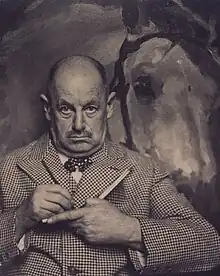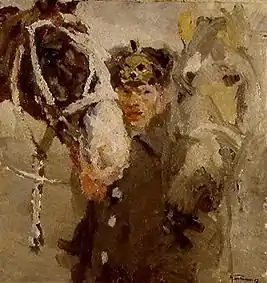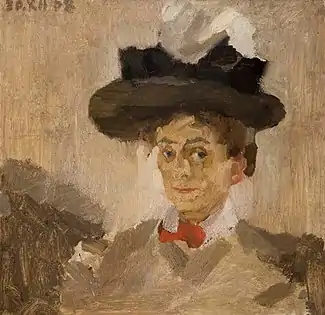Max Feldbauer
Max Feldbauer (1869–1948) was a German painter, associated with the Munich Secession. He is primarily known for rural, Bavarian scenes.
Max Feldbauer | |
|---|---|
 Photograph by Hugo Erfurth (1930) | |
| Born | 14 February 1869 |
| Died | 20 November 1948 (aged 79) |
| Occupation | Artist |
| Olympic medal record | ||
|---|---|---|
| Art competitions | ||
| 1928 Amsterdam | Graphic works | |
Life and work
His father, Josef Feldbauer, served as the Mayor of Neumarkt from 1868 to 1876. After his father and his five younger siblings had died, he and his mother moved to Munich. His first art lessons were at the Kunstgewerbeschule. He then attended the private art school operated by Simon Hollósy, where he was introduced to Impressionism, and continued his studies at the Academy of Fine Arts, Munich. His instructors there included Otto Seitz, Paul Hoecker and Johann Caspar Herterich.[1]
In 1899, he married the painter, Elise Eigner, of Schwandorf. From 1901 to 1915, he taught at the Academy of the Münchner Künstlerinnenverein (women artists' association). In 1908, he joined the Munich Secession. He also ran his own painting school, in Mitterndorf, near the Dachau art colony, from 1912 to 1922. He left the Secession in 1913; becoming one of the founders of the New Secession, and served as a board member. In addition to all of these activities, he provided illustrations for Die Jugend (Youth), a weekly arts magazine.
After several trips through France and Italy, he settled near Dachau. In 1916, he was appointed to teach at the Kunstgewerbeschule Dresden (arts and crafts school) then, in 1918, to the Dresden Academy of Fine Arts, where he served as President in 1928. After the Nazis came to power in 1933, he was initially banned from exhibiting.
He returned to Munich, but was bombed out of his home in 1944. Ironically, that same year, he was included on the "Gottbegnadeten-Liste" (God given list) of artists who were considered crucial to Nazi culture.[2] Unable to find another home, he moved to Oberschneiding, where he died four years later.
His works may be seen at the Gemäldegalerie Alte Meister, Bayerische Staatsgemäldesammlungen, Staatliche Graphische Sammlung, and the Städtische Galerie im Lenbachhaus, among others.
Selected paintings
 Roll Call of the Armored Unit
Roll Call of the Armored Unit Nude at the Oven
Nude at the Oven
 Portrait of his wife, Elise
Portrait of his wife, Elise
References
- Wolfgaang Hultsch (Ed.), Kriege, Widerstand, Frauenkirche, pg.74, Books-on-Demand, ISBN 978-37448-6762-7
- Ernst Klee: Das Kulturlexikon zum Dritten Reich. Wer war was vor und nach 1945. S. Fischer, Frankfurt am Main 2007, ISBN 978-3-10-039326-5, pg.149
Further reading
- Ewald Bender, "Feldbauer, Max" In: Allgemeines Lexikon der Bildenden Künstler von der Antike bis zur Gegenwart, Vol. 11: Erman–Fiorenzo, E. A. Seemann, Leipzig 1915 (Online)
- "Max Feldbauer", In: Hans Vollmer (Ed.): Allgemeines Lexikon der bildenden Künstler des XX. Jahrhunderts. Vol.2: E–J. E. A. Seemann, Leipzig 1955, pg.87
- Hans-Georg Behr, Herbert Grohmann and Bernd-Olaf Hagedorn Leo Putz, Max Feldbauer und der Kreis der „Scholle“ und „Jugend“ in Dachau um 1900, Verlegt bei Beltz, 1989 ISBN 978-3-407-85098-0
- Karl Breitschaft (Ed.): "125 Jahre Max Feldbauer", In: Die Neurieder Sammlung Munich 1994
- „Akt und Roß genügten mir…“. Der Maler Max Feldbauer 1869–1948, exhibition catalog, Gemäldegalerie Dachau, Dachau 2015, ISBN 978-3-930941-84-1
External links
- More works by Feldbauer @ ArtNet
- Literature by and about Max Feldbauer in the German National Library catalogue
- Biography of Feldbauer @ the Galerie Schüller